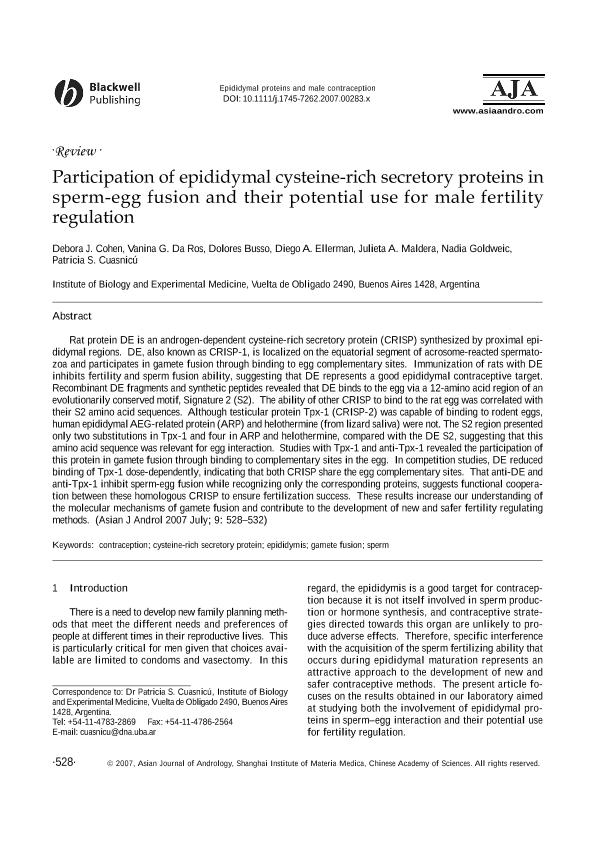Artículo
Participation of epididymal cysteine-rich secretory proteins in sperm egg fusion and their potential use for male fertility regulation
Cohen, Debora Juana ; Da Ros, Vanina Gabriela
; Da Ros, Vanina Gabriela ; Busso. Dolores; Ellerman, Diego Andrés; Maldera, Julieta Antonella
; Busso. Dolores; Ellerman, Diego Andrés; Maldera, Julieta Antonella ; Goldweic, Nadia Micaela
; Goldweic, Nadia Micaela ; Cuasnicu, Patricia Sara
; Cuasnicu, Patricia Sara
 ; Da Ros, Vanina Gabriela
; Da Ros, Vanina Gabriela ; Busso. Dolores; Ellerman, Diego Andrés; Maldera, Julieta Antonella
; Busso. Dolores; Ellerman, Diego Andrés; Maldera, Julieta Antonella ; Goldweic, Nadia Micaela
; Goldweic, Nadia Micaela ; Cuasnicu, Patricia Sara
; Cuasnicu, Patricia Sara
Fecha de publicación:
03/07/2007
Editorial:
Chinese Acad Sciences
Revista:
Asian Journal of Andrology
ISSN:
1008-682X
e-ISSN:
1745-7262
Idioma:
Inglés
Tipo de recurso:
Artículo publicado
Clasificación temática:
Resumen
Rat protein DE is an androgen-dependent cysteine-rich secretory protein (CRISP) synthesized by proximal epididymal regions. DE, also known as CRISP-1, is localized on the equatorial segment of acrosome-reacted spermatozoa and participates in gamete fusion through binding to egg complementary sites. Immunization of rats with DE inhibits fertility and sperm fusion ability, suggesting that DE represents a good epididymal contraceptive target. Recombinant DE fragments and synthetic peptides revealed that DE binds to the egg via a 12-amino acid region of an evolutionarily conserved motif, Signature 2 (S2). The ability of other CRISP to bind to the rat egg was correlated with their S2 amino acid sequences. Although testicular protein Tpx-1 (CRISP-2) was capable of binding to rodent eggs, human epididymal AEG-related protein (ARP) and helothermine (from lizard saliva) were not. The S2 region presented only two substitutions in Tpx-1 and four in ARP and helothermine, compared with the DE S2, suggesting that this amino acid sequence was relevant for egg interaction. Studies with Tpx-1 and anti-Tpx-1 revealed the participation of this protein in gamete fusion through binding to complementary sites in the egg. In competition studies, DE reduced binding of Tpx-1 dose-dependently, indicating that both CRISP share the egg complementary sites. That anti-DE and anti-Tpx-1 inhibit sperm-egg fusion while recognizing only the corresponding proteins, suggests functional cooperation between these homologous CRISP to ensure fertilization success. These results increase our understanding of the molecular mechanisms of gamete fusion and contribute to the development of new and safer fertility regulating methods.
Palabras clave:
Sperm
,
Contraception
,
Epididymis
Archivos asociados
Licencia
Identificadores
Colecciones
Articulos(IBYME)
Articulos de INST.DE BIOLOGIA Y MEDICINA EXPERIMENTAL (I)
Articulos de INST.DE BIOLOGIA Y MEDICINA EXPERIMENTAL (I)
Citación
Cohen, Debora Juana; Da Ros, Vanina Gabriela; Busso. Dolores; Ellerman, Diego Andrés; Maldera, Julieta Antonella; et al.; Participation of epididymal cysteine-rich secretory proteins in sperm egg fusion and their potential use for male fertility regulation; Chinese Acad Sciences; Asian Journal of Andrology; 9; 4; 3-7-2007; 528-532
Compartir
Altmétricas



